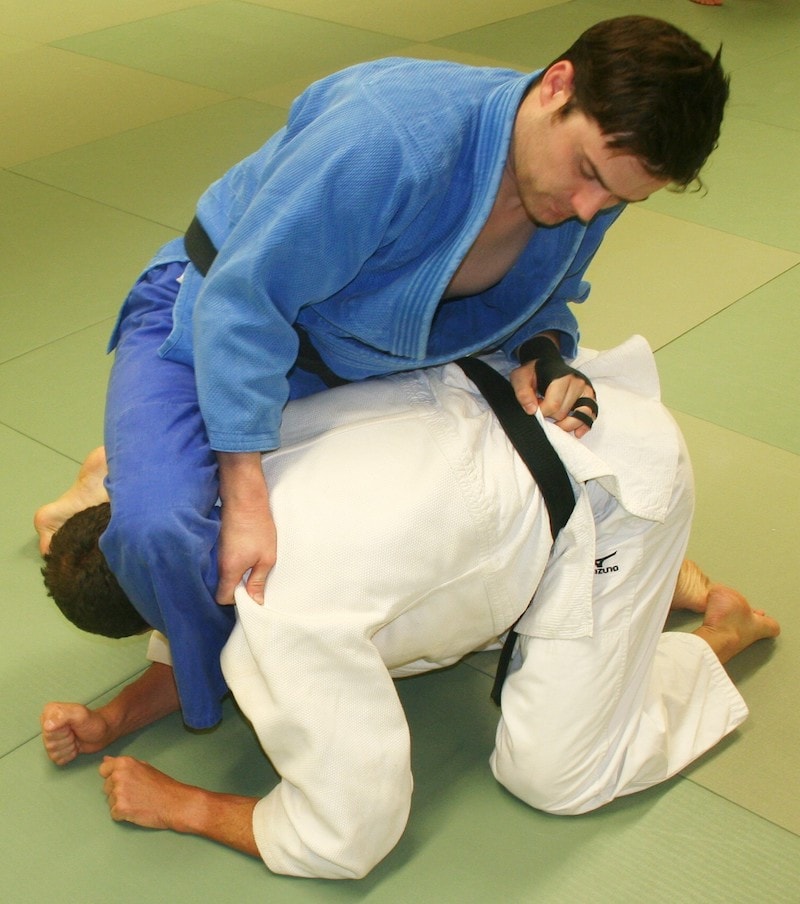James Burke's adaptation of an old mariner's saying certainly applies to the subject The Triangle Choke. Another way of saying it for our purposes might be that if we don't have some factual idea of how the triangle choke developed and evolved over the years, we won't appreciate its capacity as a functional weapon or its versatility as a tool that can be used in any fighting sport.
History of the Triangle Choke
When Professor Jigoro Kano developed Kodokan Judo in 1882, he set the stage for the growth, evolution, and expansion not only of his brilliant invention, Kodokan Judo, but for what has come to be known as martial arts in general. It was the exponents of Professor's Kano's judo (as well as Professor Kano himself) who developed the concepts of combat sports that would expand to a variety of offshoots throughout the world.
It was because of this technical experimentation, innovation, development, and growth that the concept of controlling an opponent with the legs, and then using the legs as a weapon to strangle an opponent, came into being.
In the years before Professor Kano founded his judo, what we now know as triangle chokes were not used to any degree at all. The feudal jujutsu of Japan was designed for fighting and usually fighting an armed opponent on a battlefield. There is little, if any, historical mention of strangling an opponent with the legs in any of the ancient or feudal documents chronicling the various jujutsu ryu (schools). Grappling with an enemy combatant and exposing the legs or lower extremities to a knife or sword wasn't a wise thing to do for the bujin (warriors) of that time.
So, it wasn't until the "sporting" concept of grappling was introduced to the Japanese culture through judo that such techniques as sankaku (or sangaku) jime (triangle strangles) were developed and used. The Kosen Judo exponents of the early 1900s who specialized in the groundfighting aspect of judo contributed a great deal to the early development of triangle and leg chokes. This led to a greater appreciation of triangle chokes among the top Kodokan Judo fighters who spread the word outside of Japan to an international audience.
Historically, the roots of what came to be known as katame waza (holding or grappling techniques) or newaza (groundfighting techniques starting from a supine position-what is now commonly called the guard) originate from a rival jujutsu school of the Kodokan in its early years around the turn of the twentieth century. The exponents of Fusen-ryu jujutsu proved superior to the Kodokan fighters in an early dual tournament (in 1900) and it didn't take long for Jigoro Kano to bring in Mataemon Tanabe, the headmaster of the Fusen School, to teach his students at the Kodokan Judo Institute. Additionally, Professor Kano recruited exponents of another school of jujutsu that placed emphasis on groundfighting, the Jikishin-ryu, about this same time to instruct his Kodokan pupils.
This period, from 1900 to 1906, saw a marked improvement in the quality of groundfighting among the Kodokan Judo exponents. Notably, in 1906, Professor Kano finalized his work on katame no kata (form of grappling) to compliment the already existing nage no kata (form of throwing). These two structured forms of learning technical skills formed the basis of the early teaching of judo at the Kodokan. Several of the Kodokan's top instructors, notably Hajime Isogai, Tsunetane Oda, and Yaichibei Kanemitsu (among others) formed what was known as Kansai Judo; a group of Kodokan instructors who developed the groundfighting of judo to a higher level in an attempt to be on par with the highly refined throwing techniques of Kodokan Judo.
This group, as well as others, developed the Kosen Judo movement that placed emphasis on newaza and was popular among preparatory and high school students as well as university students from 1914 to 1943.
What's A Strangle Choke?
It was in the early days of Kosen Judo that sangaku (or sankaku) jime (the triangle strangle or choke) was initially developed. Historians differ somewhat as to who exactly was the originator of sankaku jime, but it was the work of Oda, Isogai, and Kanemitsu that laid the technical foundation that saw the development of the triangle choke.
When Mitsuo Maeda introduced Kodokan Judo to Brazil (and in particular to the Gracie family) in the 1920s, he set in motion the eventual development and evolution of Brazilian Jiu-Jitsu and their approach to grappling. The Brazilian exponents took a particular liking to the triangle choke and (independently of the Kodokan and Kosen Judo movements) developed their own approach to the study and teaching of the triangle choke as a distinct and functional tool in grappling and fighting, especially when applied from the bottom Newaza (guard) grappling position.
As mentioned before, the concept of "Newaza" (techniques from a supine position—what is now commonly called the guard) was (and continues to be) a major aspect of not only Kosen Judo but also the general approach to grappling on the mat or ground used in Kodokan Judo and Brazilian Jiu-Jitsu. And this approach to fighting off of the buttocks or back led to the early development of Sankaku Jime (as well as a variety of other skills) in a highly complex and functionally effective way. As previously mentioned, the early (and current) proponents of Brazilian Jiu-Jitsu focused on this grappling position and have done much for the further technical development of the triangle choke as an effective weapon.
Strangling is the Great Equalizer
Strangles and chokes are the "great equalizer" in any form of fighting whether in a self-defense situation, law enforcement or military applications or in any of the fighting sports. Smaller or physically weaker fighters can (and do) defeat larger stronger opponents with chokes and strangles. Depriving an opponent or assailant of the ability to breathe will make even the strongest men surrender (or pass out). If someone has forced his opponent to submit or surrender from a strangle, the fight is over, and everyone knows who the winner really is. Forcing an opponent to choke, sputter, gag or go unconscious leaves no doubt who won the fight.
It's rarely a fluke when one fighter forces his opponent to give up from a choke. Maybe someone can score a "lucky punch" or a "fluke throw" but it's very rare to score a "lucky or fluke choke" on an opponent. Often, a strangling technique is the result of one grappler or fighter controlling the position of his opponent and methodically working to make the strangle effective. In many cases, a physically smaller or weaker fighter may be able to choke his larger and stronger opponent, forcing the larger fighter to submit or go unconscious.
Chokes and strangles are probably the subtlest of all fighting or grappling skills. It's okay to be "sneaky" when doing chokes or strangles. In fact, it's an asset to be sneaky when attempting to strangle an opponent. A good strangler knows how to use his hands, arms, feet, legs, or any part of his body to manipulate and control an opponent. A good strangler seems almost relaxed or "loose" but is always gripping, grabbing, holding or controlling some part of his opponent's body so that he can ultimately strangle him into submission. A good strangler has a "feel" as to how to use his hands, arms, feet, legs and other body parts independently of each other, but working together to get the job done.
The "Shime Waza" (strangling techniques) initially conceived and developed in Japanese fighting arts such as jujutsu and Kodokan Judo gave sport grappling a whole new dimension. In Japanese fighting and grappling in the early 20th Century, the theory of "Shime Waza" was an integral concept in fighting or grappling on the ground. What may have been considered "dirty wrestling" in western forms of grappling or wrestling in the late 1800s and into the early 1900s was considered just another way of gaining an advantage over an opponent to the Japanese.
An Explanation of Sankaku Jime
The method we recognize as Sankaku Jime or the Triangle Choke was (as mentioned previously) initially conceived and developed by the Japanese. To initially understand this form of strangling an opponent, let's look at the translation from the original Japanese. The word "san" means "three." The word "kaku" means "corner" or "angle." Thus, "san-kaku" is translated to "three cornered" or "triangle." The word "jime" is an adaptation of the word "shime." The "sh" is hardened to "j" when used as a suffix in the Japanese language. The word "shime" means "to tighten," "to squeeze," "to constrict," or "to shut or close." In common usage, "shime" translates to "strangle by squeezing or tightening." We could call this choke the "three-cornered squeeze" but that is too cumbersome and doesn't do this great weapon justice. Simply calling it the triangle choke seems to make the most sense.
A triangle choke takes place anytime the legs of the attacker are wrapped around his opponent at the neck area in a triangle or figure four (that has been formed by the attacker's legs and feet) and the attacker applies pressure to the neck, strangling his opponent. What is often called a triangle choke is a leg choke with the attacker forming a triangle with his legs and using the power of his legs to strangle or choke his opponent. Strangling an opponent with the strength of the legs produces some of the most powerful submission techniques ever invented or used in sport combat.
My new book, The Triangle Hold Encyclopedia, book is devoted to the basic concept of a fighter or grappler wrapping his legs and feet tightly around his opponent's neck, head and arm and strangling him with the strength of the attacker's legs.
The above is an excerpt from The Triangle Hold Encyclopedia: Comprehensive Applications for Triangle Submission Techniques by Steve Scott, Publication Date May 1, 2022,YMAA Publication Center, ISBN 9781594396496




